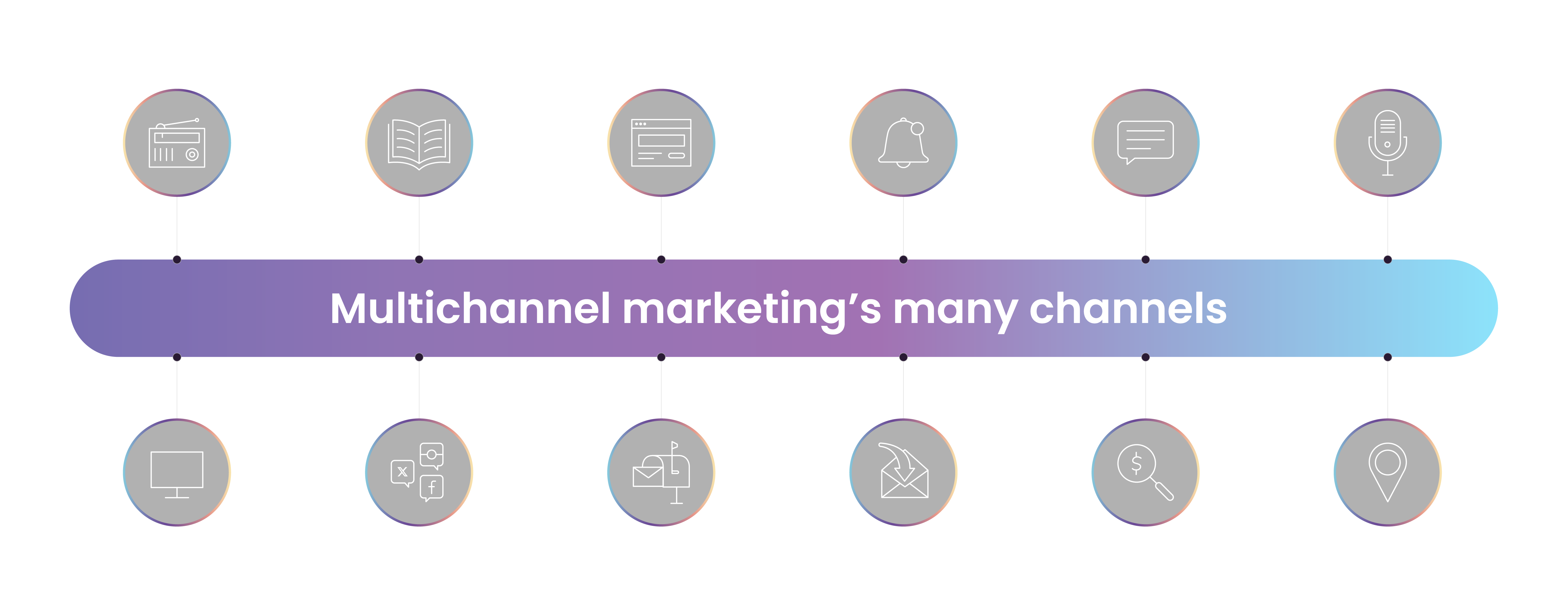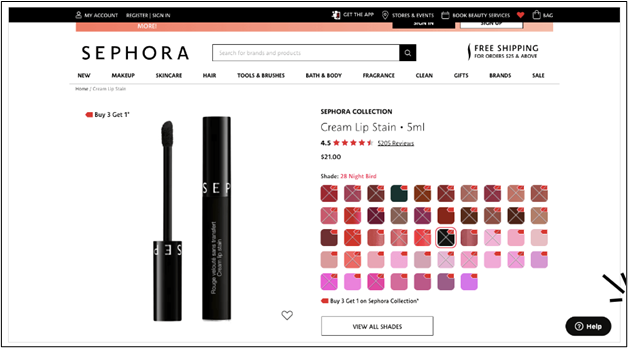In today's fast-paced and interconnected world, reaching and engaging with customers across multiple channels is essential for any business striving to stay competitive. Multi-channel marketing has emerged as a powerful strategy that enables organizations to connect with their target audience through various platforms, both online and offline.
This comprehensive guide aims to provide a complete understanding of multi-channel marketing, exploring its principles, benefits, and best practices. By delving into the intricacies of this strategy, businesses can unlock the potential to enhance brand visibility, drive customer engagement, and ultimately achieve greater success in their marketing efforts.
Here are some compelling statistics that prove the importance of multi-channel marketing:
- According to a study by Aberdeen Group, companies with strong multi-channel strategies achieve a 91% higher year-over-year increase in customer retention rates compared to those without.
- The Salesforce State of Marketing Report reveals that 75% of consumers expect consistent experiences across multiple channels, highlighting the importance of delivering cohesive messaging and branding.
- Research by Google indicates that 85% of online shoppers start a purchase on one device and continue it on another, underscoring the need for seamless cross-channel experiences.
Whether you're a seasoned marketer looking to refine your approach or a newcomer seeking to grasp the fundamentals, this article will equip you with the knowledge and insights needed to navigate the dynamic landscape of multi-channel marketing.

What is Multi-Channel Marketing?
Multi-channel marketing refers to the strategic approach of engaging with customers and prospects through multiple channels simultaneously. It involves creating a cohesive and integrated marketing strategy that leverages various platforms, both online and offline, to reach and communicate with target audiences.
These channels can include websites, social media, email marketing, mobile apps, physical stores, direct mail, and more. The goal of multi-channel marketing is to provide a seamless and consistent customer experience across all touchpoints. By utilizing multiple channels, businesses can expand their reach, engage with customers at different stages of their buying journey, and create opportunities for interaction and conversion.
This approach recognizes that consumers today are active across various platforms and expects businesses to be present where they are, offering relevant and personalized messaging that caters to their preferences and needs. Ultimately, multi-channel marketing allows organizations to maximize their visibility, foster stronger customer relationships, and drive better business results.
How Multi-Channel Marketing Differs from Cross-Channel Marketing?
Multi-channel marketing refers to the practice of reaching and engaging with customers through various independent marketing channels, such as email, social media, mobile apps, and websites. Each channel operates separately, with its own set of strategies and objectives, and may not necessarily be integrated or coordinated.
On the other hand, cross-channel marketing focuses on creating a seamless and consistent customer experience across multiple channels. It involves integrating and synchronizing marketing efforts across various channels to deliver a cohesive message and enhance customer interactions.
Cross-channel marketing aims to provide a unified experience by leveraging customer data and ensuring that each touchpoint complements and builds upon the others.
Importance of Multi-Channel Marketing
Multi-channel marketing is important because it allows businesses to reach and engage with customers through various channels, increasing their chances of connecting with their target audience.
By utilizing multiple channels such as social media, email, websites, and mobile apps, businesses can expand their reach, increase brand visibility, and attract diverse customer segments. It also enables businesses to meet customers where they are, providing convenience and accessibility.
Additionally, multi-channel marketing helps businesses stay competitive in a rapidly evolving digital landscape by adapting to changing customer preferences and behaviors, and maximizing opportunities for customer engagement and conversion.
Benefits of Multi-Channel Marketing
Increased Reach and Visibility
Multi-channel marketing allows businesses to reach a wider audience by leveraging multiple channels. By expanding their presence across various platforms and channels, businesses can increase their visibility and improve their chances of connecting with potential customers who may be active on different platforms.
This increased reach enhances brand awareness and exposes the business to a larger pool of potential customers.
Engage Customers through Their Preferred Channels
Different customers have unique preferences when it comes to communication and engagement channels. Some may prefer email, while others may be more active on social media or prefer mobile apps.
With multi-channel marketing, businesses can engage customers through their preferred channels, increasing the likelihood of capturing their attention and fostering meaningful interactions. By meeting customers where they are, businesses can create personalized and targeted experiences that resonate with their audience.
Increased Effectiveness through Channel Combination
By combining multiple channels, businesses can leverage the strengths of each channel to create a more effective marketing strategy. For example, a business can use social media to generate awareness and drive traffic to their website, where they can provide more detailed information and facilitate conversions.
The combination of channels allows for a comprehensive approach that can guide customers through the buyer's journey, from awareness to consideration and ultimately, conversion. By using different channels in a coordinated manner, businesses can optimize their marketing efforts and achieve better results.
Diversified Audience Engagement
With multi-channel marketing, businesses can engage a diverse range of audience segments. Different channels attract different demographics and customer profiles, and by utilizing multiple channels, businesses can tailor their messaging and strategies to cater to specific segments.
This diversified approach allows businesses to broaden their customer base, tap into new markets, and tailor their marketing efforts to suit the unique characteristics and preferences of different audience segments.
Maintaining a Consistent Brand Persona
Consistency in branding is crucial for building trust and establishing a strong brand identity. Multi-channel marketing provides businesses with the opportunity to maintain a consistent brand persona across different channels.
By aligning messaging, design elements, and brand voice across all channels, businesses can reinforce their brand image and ensure a cohesive and recognizable presence. Consistency builds brand credibility and fosters a sense of familiarity among customers, strengthening their connection to the brand.
Enhanced Customer Experience
Multi-channel marketing plays a vital role in enhancing the overall customer experience. By offering customers a choice of channels to engage with, businesses can provide convenience and flexibility. Customers can interact with the brand through their preferred channels, at their preferred times, and in their preferred formats.
This seamless and personalized experience creates a positive impression, improves customer satisfaction, and encourages loyalty. Additionally, multi-channel marketing allows for smoother customer journeys, as customers can transition between channels without disruptions, enabling them to have consistent and engaging interactions with the brand.
How to Create a Successful Multichannel Marketing Strategy?
Understanding Your Target Audience
To create a successful multichannel marketing strategy, start by thoroughly understanding your target audience. Conduct market research, analyze customer data, and gather insights to identify their demographics, preferences, behaviors, and pain points.
This knowledge will help you tailor your messaging and choose the most effective channels to reach and engage your audience. By understanding their needs and motivations, you can create targeted campaigns that resonate with your audience and drive desired actions.
Identifying the Right Channels
Identify the channels that align with your target audience and business objectives. Consider where your audience is most active and receptive to marketing messages. This could include social media platforms, email marketing, mobile apps, websites, and more.
By selecting the right channels, you can effectively communicate your message and engage your audience. Each channel has unique strengths, so choose channels that allow you to leverage those strengths and deliver your message in a format that suits the channel and your audience's preferences.
Creating Effective Communication
Craft compelling and relevant content that resonates with your target audience across all selected channels. Maintain consistency in your brand messaging while adapting it to suit the unique characteristics of each channel. Tailor your content and tone to maximize engagement and encourage action.
Utilize the strengths of each channel and optimize your messaging for different formats and platforms. Personalize your communication whenever possible to create a personalized and relevant experience for your audience.
Defining KPIs for Measurement
Define key performance indicators (KPIs) to measure the success of your multichannel marketing strategy. Set specific goals and metrics for each channel to track your progress and evaluate the effectiveness of your efforts.
Monitor metrics such as reach, engagement, conversion rates, and return on investment (ROI) to gain insights and make data-driven decisions. By measuring the right KPIs, you can identify what is working and what needs improvement, allowing you to optimize your strategy for better results.
Utilize a Multi-Channel Marketing Platform
Leverage a multichannel marketing platform that enables seamless management and coordination of your marketing activities. Choose a platform that integrates multiple channels, allowing you to streamline processes, automate workflows, and centralize data.
A comprehensive platform can help you plan, execute, and track your multichannel campaigns efficiently, saving time and resources while ensuring consistent messaging and performance analysis. It allows for better coordination and synchronization across channels, ensuring a cohesive customer experience.
Use a platform for Multi Channel Reporting
Utilize a reporting system that provides comprehensive insights into the performance of your campaigns across different channels. A multi-channel reporting platform should offer detailed analytics and metrics to evaluate the success of your marketing efforts.
It enables you to monitor and analyze the data from multiple channels, gaining a holistic view of your marketing performance. By leveraging the insights provided by the reporting platform, you can identify trends, spot opportunities, and make data-driven decisions to optimize your multichannel marketing strategy.
Use Arena Calibrate
Arena Calibrate empowers you to effortlessly track and measure the performance of your marketing campaigns across multiple channels. With its intuitive interface and advanced analytics capabilities, you can gain a comprehensive understanding of how each channel contributes to your overall marketing success.
By leveraging the power of Arena Calibrate, you can identify emerging trends and uncover hidden opportunities within your multi-channel marketing ecosystem. Through in-depth data analysis, you can pinpoint the most effective channels, optimize your marketing spend, and drive better results.
Retargeting Customers
Retargeting customers is a crucial aspect of a successful multichannel marketing strategy. It involves reaching out to individuals who have previously interacted with your brand but did not convert into customers.
By using tracking technology and data analysis, you can identify these individuals and deliver targeted ads or messages across various channels to re-engage them. Retargeting helps to remind customers of your brand, keep your products or services top of mind, and provide additional incentives or information to encourage them to make a purchase.
This tactic allows you to maximize your marketing efforts by focusing on a warm audience that has already shown some level of interest, increasing the chances of converting them into loyal customers.
Challenges of Multichannel Marketing
Consistent Messaging
Maintaining consistent messaging across multiple channels can be challenging. Each channel may have its own unique requirements, formats, and limitations, making it difficult to ensure a cohesive brand message and experience.
Consistency is essential to build trust and reinforce brand identity, so businesses need to carefully plan and coordinate their messaging across channels to deliver a unified brand persona.
Channel Selection
Choosing the right channels for your multichannel marketing strategy can be challenging. There are numerous channels available, and not all of them may be suitable for your target audience or align with your business goals.
Understanding your audience and their preferred channels, as well as conducting thorough market research, is crucial in identifying the channels that will yield the best results. It requires careful evaluation and strategic decision-making to determine the most effective combination of channels for your specific business.
Resource Allocation
Implementing a successful multichannel marketing strategy requires significant resources, including time, budget, and skilled personnel. Managing multiple channels, creating tailored content, and optimizing campaigns across platforms can be resource-intensive.
Allocating resources effectively and efficiently is crucial to ensure that each channel receives adequate attention and resources for optimal performance. Balancing resources while delivering consistent and engaging experiences across channels can be a challenge for businesses.
Data Integration and Analysis
Collecting and integrating data from multiple channels can be complex. Each channel may generate data in different formats and structures, making it challenging to consolidate and analyze the data effectively.
Data integration is crucial to gain a holistic view of customer behavior and campaign performance. Additionally, analyzing the data from various channels requires the right tools and expertise to extract meaningful insights and make informed decisions.
Customer Journey Tracking
Tracking the customer journey across multiple channels can be challenging. Customers may interact with your brand through various touchpoints, making it difficult to track their behavior and attribute conversions accurately.
Understanding the impact of each channel and its contribution to the customer journey is essential for optimizing your multichannel marketing strategy. Implementing effective tracking mechanisms and attribution models can help overcome this challenge.
Technological Complexity
Managing multiple channels often involves working with various technologies and platforms. Each channel may have different requirements and technical specifications, requiring businesses to adapt and navigate through different tools and systems.
It can be complex to integrate and synchronize these technologies, especially when dealing with legacy systems or when implementing new marketing technologies. Businesses need to invest in robust technology infrastructure and ensure seamless integration to overcome this challenge.
Finding the Exact Buyer Persona
Identifying the precise buyer persona for each channel can be challenging. Different channels attract diverse audiences, and it can be difficult to pinpoint the exact characteristics and preferences of each segment. Conducting thorough market research, analyzing customer data, and utilizing segmentation techniques are essential to define buyer personas accurately. However, accurately identifying and targeting the right audience for each channel requires continuous monitoring and refinement.
Multi-Channel Marketing Examples
Sephora
Sephora is an example of a company that excels in multi-channel marketing. They have a strong online presence through their e-commerce website, which allows customers to browse and purchase products online.
Additionally, Sephora leverages social media platforms such as Instagram and YouTube to provide makeup tutorials, product reviews, and engage with their audience. They also have a mobile app that offers personalized recommendations, exclusive promotions, and allows customers to book beauty services.
Sephora's multi-channel approach ensures that customers can interact with the brand through various channels, providing a seamless and convenient shopping experience.

Maggi and Wagner Pizza
Maggi and Wagner Pizza are examples of food brands that utilize multi-channel marketing effectively. They have a strong presence across multiple channels, including television advertisements, social media platforms, websites, and mobile apps.
Maggi creates engaging videos and recipes on platforms like YouTube and Instagram to inspire cooking ideas using their products. Wagner Pizza runs TV commercials to promote their range of frozen pizzas and also utilizes social media to engage with customers and offer exclusive deals.
Their multi-channel marketing strategies enable them to reach a wide audience, increase brand visibility, and drive customer engagement.
Apple
Apple is renowned for its successful multi-channel marketing approach. They have a strong retail presence with their Apple Stores, where customers can experience their products firsthand and receive expert advice. Apple's website provides detailed product information, online shopping, and customer support.
They leverage social media platforms to showcase new product launches, engage with customers, and share user-generated content. Apple also uses television commercials and print advertisements to reach a broader audience.
With a seamless integration between their physical stores, website, social media presence, and traditional advertising, Apple creates a cohesive and engaging experience for their customers, driving brand loyalty and sales.
Conclusion
In conclusion, the complete guide to multi-channel marketing emphasizes the importance of understanding your target audience, selecting the right channels, and creating effective communication to maximize the reach and engagement of your marketing efforts.
By defining KPIs, utilizing a multi-channel marketing platform, and implementing a multi-channel reporting system, businesses can gain valuable insights and measure the success of their multi-channel campaigns.
Furthermore, leveraging a multi-channel marketing tool for analyzing data from different channels enables marketers to make informed decisions and optimize their marketing campaigns. By embracing multi-channel marketing and utilizing the right tools, businesses can enhance their marketing strategies and drive better results across various channels.
FAQ of Multi-Channel Marketing
Why is multi-channel marketing effective?
Multi-channel marketing allows businesses to reach and engage with customers through multiple channels, increasing their chances of connecting with their target audience. By utilizing various channels such as social media, email, websites, and mobile apps, businesses can expand their reach and visibility.
What are the five main elements of a comprehensive multi-channel marketing plan?
A comprehensive multi-channel marketing plan typically includes the following five main elements:
- Goal Setting: Clearly define the objectives and goals of your multi-channel marketing efforts.
- Audience Analysis: Conduct thorough research to understand your target audience.
- Channel Selection and Integration: Identify the most relevant and effective marketing channels to reach your target audience.
- Content Strategy and Creation: Develop a content strategy that aligns with your target audience, goals, and selected channels.
- Measurement and Optimization: Establish a system for measuring the effectiveness of your multi-channel marketing efforts.
What is the difference between multi-channel marketing and omnichannel marketing?
The main difference between multi-channel marketing and omnichannel marketing lies in the level of integration and customer experience consistency across channels.
Multi-channel marketing refers to the practice of reaching and engaging with customers through various independent marketing channels, such as email, social media, mobile apps, and websites. On the other hand, omnichannel marketing aims to create a seamless and consistent customer experience across multiple channels.
What are some emerging trends and technologies influencing the future of multi-channel marketing?
Several emerging trends and technologies are influencing the future of multi-channel marketing:
- Voice Search and Smart Speakers: The rise of voice search and smart speakers, such as Amazon Echo and Google Home, is changing how customers interact with brands.
- Artificial Intelligence (AI) and Machine Learning: AI and machine learning technologies offer opportunities for personalized and targeted marketing at scale.
- Augmented Reality (AR) and Virtual Reality (VR): Businesses can leverage AR and VR to provide virtual product try-ons, virtual showrooms, or enhanced storytelling experiences, creating memorable and engaging interactions with customers across different channels.





